Simple Circuits Curriculum
Section 2: Lesson Plan
Materials
- White boards (apx. 1 1/2 x 2 feet) or pieces of large paper to draw models
- Bulb with glass top removed
- Shower curtain, preferably white or off-white, with circuit drawn on it; or a white board with circuit drawn on it and black and white magnetic disks
- Tennis balls, 4
- Tennis ball can, 1 (2 cans can be taped together for a longer model)
- Clear tubing, apx. 3 feet in length, 1 1/2 inches in diameter (available at most hardware stores)
- Black and white marbles, apx. 100 of each
- Comparing Causal Models for Electricity Program
- Using Cyclic Simultaneous Causality to Explain the Simple Circuit sheet (PDF 74 KB)
- Thinking About Causality and the Simple Circuit: Why is it so Hard? sheet (PDF 110 KB)
Prep Step
- Review the lesson plan, background information, and understanding goals.
- Remove the top of a bulb (following the directions in the How to Open a Light Bulb Without Breaking the Insides sheet - PDF 116 KB) so that students can see the wires and their placement.
- Draw a circuit pattern with battery, bulb and wires on the shower curtain. The drawing should be large enough to fill the shower curtain. See the Bulb and Battery Circuit Model (PDF 69 KB) and a photograph of what a finished shower curtain looks like (PDF 227 KB).
- Gather black and white marbles, dividing the lot so that there are enough to fill the clear tubing and reserving the rest to demonstrate the flow of electrons on the shower curtain model (see photo below).
- Gather clear tubing. Fill the tube with black and white marbles side by side and tape the tubing closed to keep marbles from escaping (see photo below).
- Gather the tennis ball canister and balls. Cut the bottom off of the tennis can and remove the label (see photo below).
- Have computer and monitor set up for the software simulation, Comparing Causal Models for Electricity.
- Photocopy the sheets Using Cyclic Simultaneous Causality to Explain the Simple Circuit and Thinking About Causality and the Simple Circuit: Why is it so Hard?.
- Read the Picture of Practice.
Analyze Thinking
Step 1: Analyzing Configurations That Work to Find Patterns
Have students put the configurations of the four models that they worked on from the previous lesson on the board. Discuss what is similar and different about them. Also, ask a few students to explain what their explorations were like. What are some of the first things they tried? What did they learn from it? What are some of the later things that they tried and what made them decide to try these things?
Explain to the students that this lesson will focus on the models that they drew to explain the simple circuit following Lesson 1. However, before doing that, you'd like to share some additional information and give them a chance to revise their models in whatever ways make sense to them given the new information.
Step 2: Considering How the Bulb is a Part of the Model
Ask the students to do a quick sketch in their journals or on a sheet of paper of what they think the inside of a bulb looks like based on their observations from the previous lesson. Give them a few moments to draw what they infer must be inside.
Invite some students to share their ideas. Next, show students a bulb with the top removed. (Refer to How to Open a Light Bulb Without Breaking the Insides for instructions). Point out the wire coming out the side of the bulb and the other wire coming from the bottom of the bulb and be sure that students note the arrangement of the wires. How do these spots correspond to where they put their wire or battery contacts to light the bulb? Have them refer back to their sheets, Simple Circuits: What Works? to remind them of their findings.
Step 3: Analyzing Revised Student Models
Ask all of the students to choose one of the models that they did for Lesson 1, Step 3 and draw it on an individual white board. They should feel free to revise their model based upon what they now know about the design of a bulb.
As students are working, circulate and look for a representative set of models to focus the class discussion. Try to include examples of Simple Linear Models, Double Linear Models, Cyclic Sequential Models, and if any students have created them, Cyclic Simultaneous and/or Relational Models. Ask these students to share their models with the class.
Discuss each of the models in turn. It helps to structure the conversation by beginning with a Simple Linear Model, moving next to a Double Linear Model, and then to a Cyclic Sequential Model (and if anyone drew them, Cyclic Simultaneous or Relational Models). Remind the class that models typically work in some ways and not others. When considering the models, they should think about what evidence it helps to explain and what evidence it doesn't. Guide the discussion in this direction as students share their ideas.
Note to Teacher: A good assessment that can be conducted at this point in the unit, and again at the end, is to ask students what would happen if you increased the length of the wire between the battery and the bulb. Students will often say that it will take longer for the bulb to light and that the difference is observable. Others will say that the electrons just "know" that they have further to travel so they speed up. Others may realize that it won't take longer (not in any way that anyone could notice) 1 because there are atoms making up the wire (that are in turn made up partly of electrons).
RECAST Thinking
Step 4: Comparing How Well the Models Explain the Simple Circuit
To help students evaluate the various models, offer the following information. Share the rule that electrons are conserved. They don't disappear or get used up. What does this suggest for the models on the board? There has to be a place for the electrons to go. Electrons are atomic particles that make up matter. They are very tiny, but still they are "stuff." Which models violate that principle? Which ones follow it? Guide students to the realization that models that have an end, such as the Simple Linear or Double Linear Models, violate this principle.
Focus on the cyclic models on the board. Typically a couple of students have drawn a Cyclic Sequential Model. If this is not the case, draw one on the board and ask students to explain how it works. Ask why the cyclic part is important. Explain that you will be illustrating some different ways to think about the cyclic models to help students see how their models work and how they could work better.
The following activities illustrate aspects of the abstract process of electrical flow and offer ways to introduce the Cyclic Simultaneous Model. Use one or both activities to focus the discussion of models with your students.
Step 5a: Contrasting the Cyclic Sequential and Cyclic Simultaneous Models Using the Shower Curtain Illustration
This illustration uses a shower curtain with a circuit pattern drawn on it, some clear plastic tubing, black and white marbles, a clear tennis can with the bottom removed, and four tennis balls. The shower curtain shows a cyclic path. As an alternative to using the shower curtain and marble model, one teacher recommended drawing the model on a whiteboard and using black and white magnetic disks to represent the circuit and flow of electrons and protons.
Set the shower curtain out on the floor and gather students around it. Explain that it shows a battery, a wire "path," and a bulb, and that you are going to use it to show them the difference between a model called a Cyclic Sequential Model and one called a Cyclic Simultaneous Model. Write each term on the board.
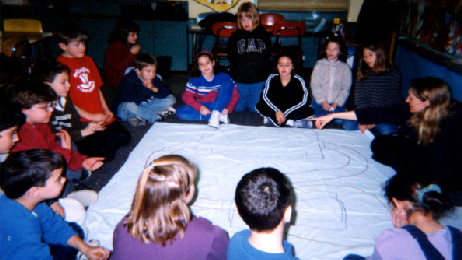
Discussion of a Cyclic Sequential Model Using the Shower Curtain Illustration
First, talk about the Cyclic Sequential Model with your students. Explain that this model is similar to what many of them drew and to what a lot of people (including adults) believe. In the battery, there is a concentration of electrons at the negative contact and a concentration of protons at the positive contact. Illustrate this by putting white marbles for protons at the positive contact and black marbles for electrons at the negative contact. When the battery is hooked up electrons start to flow onto the wire path, through the bulb, and to the positive terminal. Put some black marbles at the "beginning" of the path to illustrate electrons moving onto the wire.

Example of a Cyclic Sequential Model
Ask:
- What makes the electrons move onto the wire? The other electrons at the negative terminal repel them and so they move away. The lower concentration of electrons on the wire allows electrons from the battery to move onto the wire and fill it up.
- What makes the bulb light up in this model? When the electrons reach the bulb, the bulb lights. Then the electrons keep on going and go back to the battery and to the positive terminal.
- What are some things that work about this model? It explains the cyclic configurations. It recycles electrons so they don't get stuck anywhere.
- What are some things that don't work about the model? It doesn't explain why, if the electrons don't immediately reach the bulb, it still lights right away, with no time delay. It shows the wire as empty, and because the wire is made of electrons and protons, it cannot ever be empty.
You can test whether or not is actually takes time for the electrons to reach the bulb by increasing the length of the wire to see what happens. (For this you will need a piece of wire that is at least one to two feet in length.) Students will not be able to perceive any difference. However, this is not necessarily convincing evidence for a few reasons:
- Some students will think that if the light switch is far from the lights, the electrons can just speed up at will;
- Some students think that electricity "travels" so fast that you couldn't see a difference anyway; and
- There actually is a small imperceptible transient delay in the measure of nanoseconds. This is because it can take a small amount of time for the circuit to reach "steady state" (where the circuit has different concentrations of electrons, resulting in flow, as explained in Lesson 8).
Connect this to their real world knowledge.
Ask:
- If there were an electrical outage in your neighborhood, would all the lights go out and come back on at once or in a sequential pattern?
- What do you know about the nature of matter? All matter is made up of atoms, which are made up of electrons, protons, and neutrons.
Another problem with the Cyclic Sequential Model is that it doesn't take into account that the wire is made up of atoms and atoms are made up of protons and electrons. The wire can't possibly be "empty."
Next contrast the Cyclic Sequential Model to another model that fits a little better with how scientists think about what is happening: the Cyclic Simultaneous Model. Line the entire wire path with white and black marbles next to each other—proton and electron "partners" (or explain that the entire path would be lined with electrons and protons).
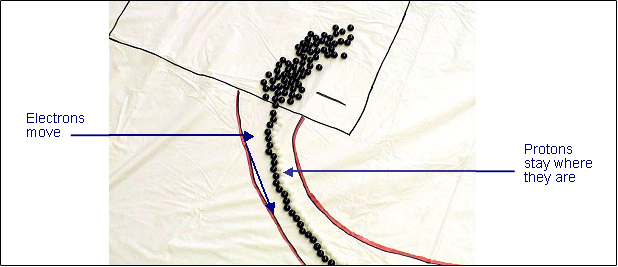
Example of a Cyclic Simultaneous Model
Ask:
- What will happen as electrons come in contact with other electrons? Students who understand static electricity will realize that each electron will be repelled by the electron "behind" it and will repel the electron "ahead" of it in the circuit.
Explain to your students that in the Cyclic Simultaneous Model, the wire already has electrons all around it and when you hook up the wire, each electron begins to repel (and be repelled by) the ones on either side of it. Each electron is a cause and an effect. It causes the one beyond it to move at the same time that the one behind it causes it to move. It is like a bicycle chain: the whole thing moves at once. Electrons move or flow along the path. Protons stay where they are.
Discuss the process of the electron movement as simultaneous; that it happens all at once. Show students a tube filled with marbles to convey the idea that all of the electrons have to move together, when more are put in the end, more move out the other end. It can be difficult to get the black and white marbles lined up in the tube to show just the black ones moving. At this point, you could just fill the tube with black ones as long as your students are aware that the protons are still there.
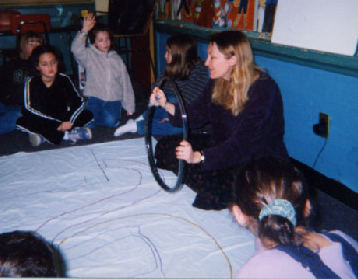
Marble Illustration of Cyclic Simultaneous Model
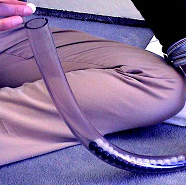
Setting up the Tube and Marbles
It can be tricky to line the marbles up in the tube so that the white ones are all on one side and the black ones on the other. There's no need to worry about this. How the marbles line up in the tube invites a nice opportunity to discuss the nature of models. No model is the same as the actual phenomenon it attempts to show. It represents the phenomenon and makes certain compromises in the process.
Ask students to consider in what ways the marbles in the tube are like the electrons and protons along a circuit and in what ways they are not. How would the actual electrons and protons behave? Students might make some of the following critiques of the model: There are many, many electrons and the electrons are actually much smaller than the protons. They are not neatly matched, one to one with a partner. There is no such thing as a static model and that electrons would not just sit next to other electrons as in the marble tube, and so on.
You can also show this idea with a tennis ball can and some tennis balls as well: as you push one ball in, another one comes out. Explain that the tennis can and clear tubing with marbles work to show the kind of movement, but they are not good models in the sense that they look "filled up." The idea is more that there are electrons all along the wire because the wire is made up of them, not so much because it is "filled up."
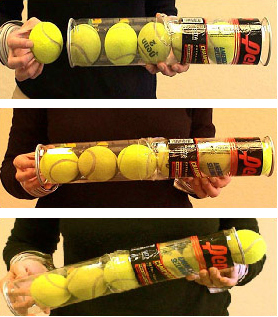
Tennis Can Illustration of Electrons Simultaneously Repelling and Being Repelled
Another way to show the illustration is to have students role-play the parts of electrons and protons. In order to differentiate electrons from protons, give students tags of opposite colors or tags with pluses and minuses, or choose students wearing opposite color shirts. Acting out the scenario engages students in thinking through the behavior of protons and electrons. However, it is slightly more difficult to visualize the overall process when one is playing a particular role in it. Therefore, some teachers have opted to have the straight discussion to introduce the ideas and then act it out to reinforce those ideas.
Step 5b: Contrasting the Cyclic Sequential and Cyclic Simultaneous Models Using the Software Simulation
Another way to contrast the two models is by using the software, Comparing Causal Models for Electricity provided with this module. Even if you do the shower curtain illustration, you can use the software simulation to reinforce the concepts. As you talk about the computer simulation, engage students in the conversation outlined above for the shower curtain illustration. The software simulation shows both the Cyclic Sequential and Cyclic Simultaneous Models. It gives some other options that you may wish to use depending upon what ideas the students bring to the unit. For instance, you can turn the protons on or off, and show both protons and electrons moving (though only the electrons actually move in the circuit). These options are given because they fit with ideas that students tend to bring to the unit and provide a means for teachers to address those ideas.
Step 6: What is the Role of the Battery in the Cyclic Simultaneous Model?
Some students will realize that the electrons are going towards the positive contact of the battery as electrons are attracted to the excess of protons there. Scientists think of the primary force as a push from the electrons behind, but students may also think of it as a pull from the protons in the battery. Students may also realize that once electrons flow into the positive terminal and accumulate there, they could begin to repel the electrons and stop the flow. Why don't they? This question leads nicely into a discussion of the role of the battery.
Explain to the students that the "work" of the battery is to move charges, which results in an excess of protons on one end of the battery and an excess of electrons on the other end. This is work because the protons and electrons are attracted to each other, and creating an excess of electrons (which repel each other) and protons (which repel each other) requires energy that is provided by the chemicals in the battery. In Lesson 8, students will learn that the excess of electrons at the negative contact, and a depletion of electrons at the positive contact (leaving an excess of protons at the positive contact) results in a differential. This causes the electrons to flow away from areas of higher concentration to areas of lower concentration of electrons.
Explore Causality
Step 7: Analyzing Cyclic Sequential and Cyclic Simultaneous Causality
Ask the students to think about each cyclic model. First, find out what questions they have about the models. Second, have the students compare and contrast the models. What are the differences and similarities between them? Which model does a better job of explaining the circuit, and why? What evidence can they think of to support their choice?
Review each model in terms of its explanatory fit.
- What problems does the Cyclic Sequential Model solve? The electrons are conserved. It explains why you need a cycle.
- What problems does the Cyclic Sequential Model create? The wire appears empty before it starts to flow.
- How is the Cyclic Simultaneous Model different from the Cyclic Sequential Model? Notice that with the Cyclic Simultaneous Model the bulb lights when the flow starts, as opposed to the Cyclic Sequential Model where it lights when the electrons get to the bulb.
- Discuss what problems the Cyclic Simultaneous Model solves. You can lengthen the wire and not observe a delay. The wire is made up of electrons and protons, and this fits with the model.
The Cyclic Simultaneous Model helps students to reason about the circuit as a system. It will help students analyze what is going on in slightly more complex types of circuits, which they will encounter in future lessons. Read the sheet entitled, Using Cyclic Simultaneous Causality to Explain the Simple Circuit as a class.
Step 8: Taking a Step Back to Consider Different Forms of Causality: Linear vs. Cyclic, and Sequential vs. Simultaneous
Introduce the sheet, Thinking About Causality and the Simple Circuit: Why is it so Hard?. This sheet is designed to take a careful look at the causal concepts embedded in the models above. It contrasts linear versus cyclic causality and explains what is difficult to understand about cyclic causality. It is intended to help students realize why linear models are appealing even though they don't work in this case. Next, it contrasts sequential versus simultaneous causality and considers why it is hard to grasp simultaneous causality. Read the sheet together and discuss it.
Review, Extend, and Apply
Step 9: Making Connections: Why is the Linear Model so Hard to Resist?
Even after students have learned about circuits, many of them go back to explaining how a circuit works in a linear way. Ask the students to reflect on what makes it so hard to think about a circuit as a cycle, and to write down their thoughts. Why might someone think about electricity in a linear way? (Example: A lamp has one cord. This makes you think electricity only goes into the lamp.) Each student should aim for 2-3 ideas.
Discuss together why it is hard to remember that the causal model should be cyclic. Consider what you can do to help each other move beyond a linear model. One way is to take linear examples and show how they really aren't linear. For example, take an electrical cord and divide it down the center, revealing that it has two halves and is really not a line after all. It is part of a big circle.


